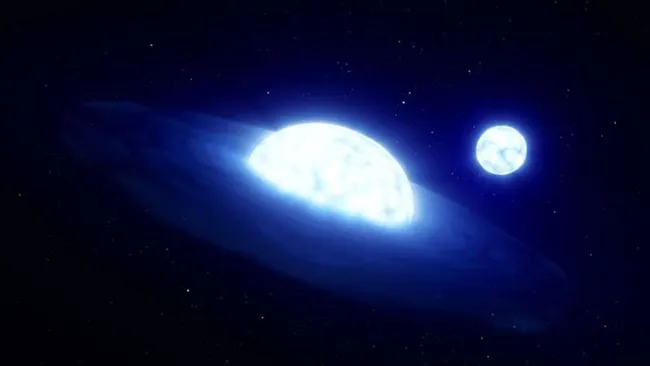“New Study Uncovers Potential Hidden Accomplice in ‘Vampire’ Stars Depleting Their Companions”
Researchers speculate that type-Be ‘vampire’ stars expand by preying on their smaller counterparts. Recent findings propose the presence of a crucial third participant in these systems.
New research published in the journal Monthly Notices of the Royal Astronomical Society suggests that the universe might be home to a higher number of triple-star “vampire” systems than previously believed. The study delves into the evolutionary patterns of a mysterious category of stars known as type-Be stars, which, unlike their bright and ordinary type-B counterparts, exhibit rapid rotation and feature enigmatic rings of orbiting matter that lack a definitive explanation.
Utilizing high-precision data from the Gaia and Hipparcos satellites, scientists at the University of Leeds in the UK have demonstrated that the peculiar characteristics of type-Be stars could potentially be elucidated by the gravitational influence of two additional companion stars orbiting the primary star in many Be systems. Lead study author Jonathan Dodd, a PhD student at the University of Leeds, described these three-star systems as “the next hot topic” in their latest research. The team’s findings suggest that such systems, consisting of more than two stars, might be more prevalent in the universe than previously anticipated.

In the Presence of a Wobble
The researchers embarked on a study to investigate the mechanism behind the rapid spin and distinctive rings observed in Be stars. The prevalent hypothesis suggests that these stars originate from binary systems, where two stars orbit a common center of mass. In this scenario, Be stars extract material from their smaller companion, causing it to accumulate in a ring around the larger star.
Simultaneously, this process adds angular momentum, causing the Be star to spin faster. This explanation has solidified Be stars’ classification as “Vampire stars,” yet the supporting evidence has been inconclusive. To address this, the study authors scrutinized data on the positions and movements of stars across the celestial sphere, aiming to identify binary systems and compare their prevalence in standard B stars versus the faster-spinning Be stars.
To achieve this, the team employed a methodology akin to that used by German astronomer Friedrich Wilhelm Bessel in 1844 during the initial observation of a binary star. By observing a wobble in the trajectory of Sirius, Earth’s brightest visible star, Bessel inferred that gravitational interactions with a companion star were responsible. The wobble arises from a disparity in the center of mass of the binary system and the center of the combined light emitted by the stars.
Beware of the Gap
Surprisingly, the researchers discovered that Be stars had fewer binary systems than B stars. Approximately 28% of observed Be stars were binary, compared to about 42% of observed B stars. One possible explanation was that in Be systems, the vampire star had depleted its partner’s matter to such an extent that the wobble in the star’s path was no longer detectable. However, the mystery deepened when the team observed that the reduced prevalence of binaries was specific to a certain range of separation distances between the component stars. Separations beyond that range were too extensive for the Be star to extract material from its companion.
The researchers unraveled the puzzle by examining data for star systems where the companion star had been stripped of its material. They found that a Be star with a companion orbiting within the range where binaries were less common was more likely to be part of a system with more than two stars.
Although any system with more than two objects is inherently chaotic, it tends to form more stable configurations when two closely spaced objects are orbited by additional objects at a much greater distance. These more distant stars also tend to bring the inner two stars closer together. Consequently, binaries with separations within the underrepresented range for Be stars were more likely to involve an additional companion.
This third star would drive the inner two stars closer together before potentially being ejected due to the chaotic nature of the orbit. With the inner stars brought closer, the Be star could then prey on its companion, gaining spin and forming a ring. The data thus supports the notion that these stars are indeed vampires. As Dodd expressed, “[The triples] are a more significant factor than we previously thought.”
This article is republished from Live science under a Creative Commons license. Read the original article.
Do not forget to share your opinion with us to provide you with the best posts !



0 Comments